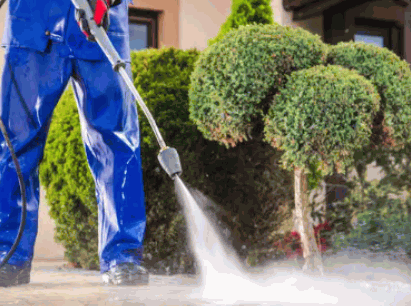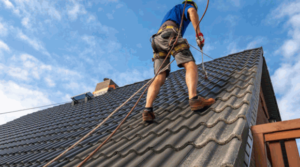If you’re looking to give your patio a thorough cleaning, a pressure washer might just be the tool you need.
Explore the different types of pressure washers, the key factors to consider when choosing one for your patio, and the steps to use it effectively.
Learn about important safety precautions and maintenance tips to keep your pressure washer in top condition and transform your patio into a sparkling oasis!
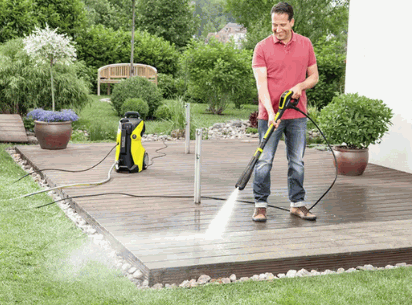
What Is A Pressure Washer?
A pressure washer is a versatile cleaning tool designed to efficiently tackle a variety of cleaning tasks by utilising high-pressure water flow rates, powered by a motor to remove dirt, grime, and mud from surfaces such as patios, cars, bikes, and more.
One of the key components defining the effectiveness of a pressure washer is the motor power. The motor dictates the water pressure and flow rate, directly impacting the cleaning performance.
Similarly, the water flow rate of a pressure washer determines how quickly and thoroughly it can clean a surface.
The hose length plays a vital role in providing flexibility and reach while cleaning different areas, ensuring efficient cleaning even in hard-to-reach spots.
Gain insights: How Do Pressure Washer Nozzles Work
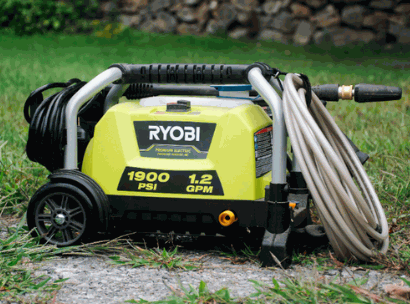
Why Use A Pressure Washer For Patio?
Using a pressure washer for patio cleaning is an effective way to remove stubborn dirt and grime quickly and efficiently, ensuring that your outdoor space remains clean and inviting.
One of the main advantages of utilising a pressure washer on your patio is the unparalleled cleaning power it offers. The high-pressure water jet can easily blast away deep-seated dirt, mould, mildew, and other stubborn stains that may have accumulated over time. This results in a thorough and effective cleaning process, leaving your patio looking fresh and rejuvenated.
The efficiency of a pressure washer cannot be overstated. Compared to manual scrubbing or traditional cleaning methods, a pressure washer can significantly reduce cleaning time and effort, allowing you to complete the task in a fraction of the time while achieving exceptional results.
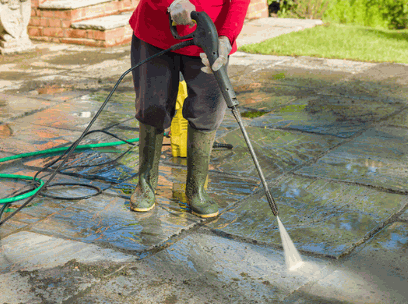
What Are The Types Of Pressure Washers?
Pressure washers come in various types, primarily categorised into electric and gas models, each offering distinct features and benefits tailored to different cleaning needs and preferences, with popular brands such as Kärcher, Bosch, Nilfisk, and Husqvarna leading the market.
Electric Pressure Washer
Electric pressure washers, such as the Kärcher K4 Power Control and Bosch EasyAquatak 110, are known for their convenient size, manageable power, and extended hose and cable lengths, making them ideal for home and light-duty cleaning tasks.
These electric pressure washers offer a user-friendly experience, with many models featuring adjustable pressure settings that cater to various surfaces and cleaning needs. The convenience of simply plugging them in and pressing a button for instant cleaning power is unparalleled. In addition, their relatively lightweight design allows for easy manoeuvrability around the house without causing strain on the user.
One of the standout advantages of electric pressure washers is their admirable power output despite their compact size. They can easily tackle stubborn dirt, grime, and debris on surfaces like driveways, patios, and vehicles without the need for excessive physical effort from the user.
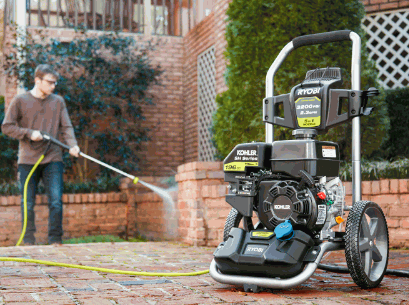
Gas Pressure Washer
Petrol pressure washers, such as those offered by Husqvarna and Ryobi, deliver superior motor power and high cleaning power, making them suitable for heavy-duty cleaning tasks and larger outdoor areas.
These robust petrol-pressure washers are designed to tackle tough cleaning jobs with ease. Equipped with powerful engines, they generate high water pressure levels, perfect for stripping paint, removing grime from driveways, and even washing first-floor cladding.
- Brands like Simpson and Generac are known for producing durable petrol pressure washers that excel in commercial settings, where frequent and demanding use is common. These machines are ideal for professional cleaners, construction sites, and farms where heavy machinery and equipment need thorough cleaning.
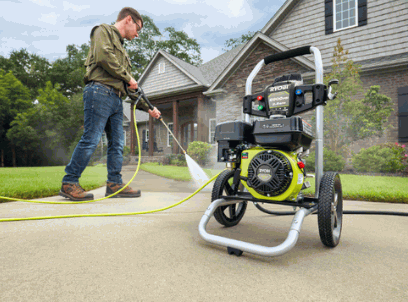
What Are The Factors To Consider When Choosing A Pressure Washer For Patio?
When choosing a pressure washer for patio cleaning, several critical factors must be considered, including the pressure rating (PSI), water flow rate (GPM), power source (electric or petrol), portability, and price, to ensure you select the right model for your specific needs and budget.
Pressure (PSI)
Pressure, measured in PSI (pounds per square inch), is a critical factor that determines the cleaning power of a pressure washer, with higher PSI models being more effective for tougher cleaning tasks.
For instance, a pressure washer with a PSI rating of 1500-2000 is ideal for routine cleaning of outdoor furniture, vehicles, and decks. On the other hand, heavy-duty tasks like stripping paint or cleaning concrete require a more robust PSI of 3000 or higher. The PSI rating essentially indicates the force with which water is expelled from the pressure washer, directly impacting its ability to remove dirt, grime, and stains efficiently.
Flow Rate (GPM)
Flow rate, or gallons per minute (GPM), is another crucial factor, determining how much water a pressure washer uses, with higher GPM models offering greater cleaning efficiency for large areas.
Higher GPM ratings mean more water flowing through the pressure washer, which translates to a higher volume of water dispensed during cleaning.
This increased water volume leads to faster cleaning of surfaces by covering more area in a shorter time span, making it especially useful for large-scale cleaning projects.
On the other hand, lower GPM models may require more time and effort to achieve the same level of cleanliness, as they dispense less water per minute, thereby extending the duration of cleaning tasks.
Power Source
Choosing the right power source, whether electric or gas, is essential as it determines the portability, power, and types of cleaning tasks your pressure washer can handle.
Regarding electric pressure washers, they are generally lighter in weight and easier to manoeuvre compared to gas models. They are also quieter, making them ideal for indoor use without causing disturbances. On the other hand, gas pressure washers provide more power and are not limited by electrical cords, allowing for increased mobility over larger areas. They tend to be heavier and require more maintenance.
Portability
Portability is a key consideration, with factors like size, weight, and design playing significant roles in how easily a pressure washer can be moved and stored.
When choosing a portable pressure washer, one of the primary benefits is the convenience it offers in terms of manoeuvrability. Compact models with lightweight construction enable users to easily transport the equipment to different areas without straining themselves. A well-thought-out design, such as integrated wheels or handles, can further enhance the ease of movement. These features not only make it simpler to navigate around obstacles but also contribute to efficient storage when the pressure washer is not in use.
Price
Price is a crucial factor, with pressure washers ranging from affordable models offering basic features to more expensive units with advanced functionalities and superior performance.
When considering the price range of pressure washers, it’s important to find a balance between your budget and the level of performance you require. Value for money is key here, as sometimes a mid-range model can offer all the necessary features without breaking the bank.
For example, a budget-friendly pressure washer may lack certain advanced functions but could still be highly effective for regular home use. On the other hand, high-end models with top-of-the-range features and power are ideal for demanding tasks or professional settings.
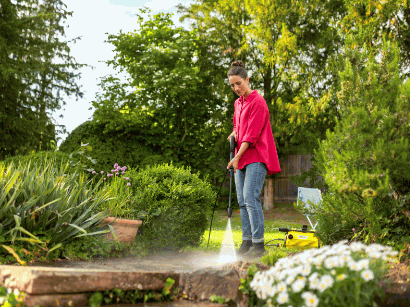
What Are The Steps To Use A Pressure Washer For Patio?
- Using a pressure washer for patio cleaning involves several essential steps, including:
- Preparing the area
- Connecting the water supply
- Setting up the pressure washer
- Testing and adjusting pressure settings
- Executing the cleaning tasks to achieve optimal results
Prepare The Area
Before starting, it’s essential to prepare the area by removing any obstacles, sweeping away loose dirt, and protecting nearby plants and furniture to ensure a smooth and efficient cleaning process.
Creating a clear workspace not only enhances the efficiency of the pressure washing task but also ensures better results. Clearing the area of any patio furniture, potted plants, or decorative items prevents accidental damage and allows for unrestricted access. Checking for electrical outlets and covering them with protective materials is crucial for safety. Inspecting the area for any fragile items that could be affected by high-pressure water is essential prior to cleaning. By taking these precautionary steps, you can maintain the integrity of both the patio surface and surrounding elements.
Connect The Water Supply
Connect the pressure washer to a suitable water supply, such as a main or outside tap, ensuring a steady flow of water for optimal performance.
To properly connect your pressure washer to water, it is crucial to follow a few simple steps. First, locate a suitable water source, like a garden hose, and attach it securely to the inlet of the pressure washer. Ensure there are no kinks or blockages in the hose that could disrupt the water flow. Once connected, turn on the water supply gradually to prevent sudden surges that may damage the machine. It is recommended to use clean, fresh water to prolong the life of your pressure washer and prevent clogs in the nozzles.
Set Up The Pressure Washer
Set up the pressure washer by assembling all necessary components, including attaching the hose and adjusting the cable length, to ensure everything is in place for effective operation.
Proper assembly of the pressure washer components is crucial for optimal performance. Begin by reading the manufacturer’s instructions carefully to understand the setup process.
When attaching the hose, make sure it is securely connected to both the water source and the washer unit to prevent leaks during operation.
Adjusting the cable length is essential for safety and convenience reasons, ensuring that the cable does not become tangled or pose a tripping hazard.
Taking the time to set up your pressure washer correctly will not only enhance its efficiency but also prolong its lifespan.
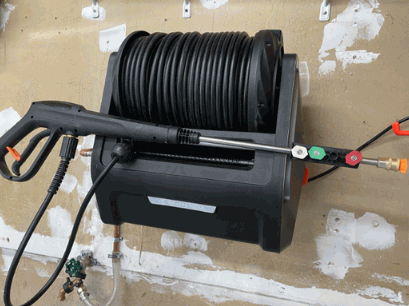
Test The Pressure And Adjust Settings
Before starting the cleaning process, test the pressure and adjust the settings to ensure the cleaning jet is at the right level for effectively tackling dirt and grime on your patio.
Testing and adjusting the pressure settings on your pressure washer can make a significant difference in the outcome of your cleaning tasks. Proper pressure ensures that you can efficiently remove tough stains and debris without causing damage. It’s essential to find the sweet spot for each surface – use lower pressure for delicate areas like windows or higher pressure for concrete driveways. Experiment with different pressure levels on a small inconspicuous area before tackling the entire surface to avoid any unintended consequences.
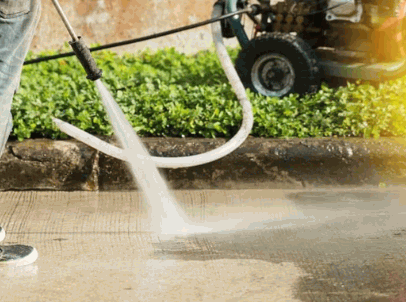
Start Cleaning
Begin the cleaning process by directing the pressure washer’s nozzle at the patio surface, systematically removing dirt, grime, and other debris for a thorough and spotless finish.
It is essential to start with a wider spray pattern to cover larger areas and then gradually switch to a narrower pattern for stubborn stains. Adjusting the pressure levels according to the surface material is crucial; for example, use lower pressure for wooden decks and higher pressure for concrete.
When dealing with tough grime, pre-treating the surface with a suitable detergent can significantly enhance the cleaning process. For oily stains, adding degreasing agents to the cleaning solution can work wonders.
Remember to maintain a consistent distance from the surface and move the nozzle in a controlled manner to prevent accidentally damaging the patio.
Once the cleaning is complete, allow the patio to dry thoroughly before returning furniture and plants to their place.
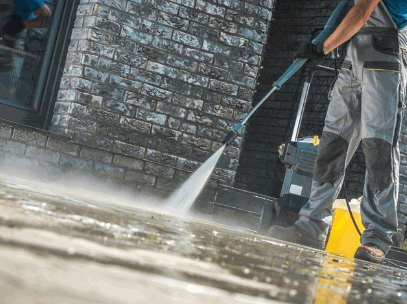
What Are The Safety Precautions When Using A Pressure Washer For Patio?
When using a pressure washer for patio cleaning, it’s crucial to follow safety precautions such as:
- wearing protective gear,
- maintaining a safe distance,
- being careful with electrical outlets,
- and using the correct nozzle to prevent accidents and ensure effective cleaning.
Wear Protective Gear
Always wear protective gear, including gloves, safety glasses, and sturdy footwear, to safeguard yourself from potential injuries while operating the pressure washer.
Each piece of protective gear plays a crucial role in ensuring your safety.
- Gloves shield your hands from sharp debris or chemicals that may splash back.
- Safety glasses protect your eyes from high-pressure water spray or any debris flying off surfaces.
- Wearing sturdy footwear with a good grip minimises the risk of slipping on wet surfaces.
By wearing this gear, you reduce the chance of cuts, abrasions, burns, or eye injuries, making your pressure-washing experience safer and more efficient.
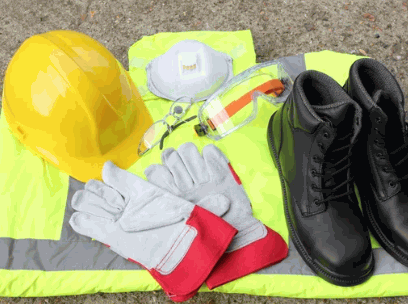
Keep A Safe Distance
Maintain a safe distance from the surface you’re cleaning to avoid injury from high-pressure water and to prevent damage to the patio surface.
When using a pressure washer, standing too close can not only pose a risk to your safety but also harm the surface being cleaned. The ideal distance varies depending on the nozzle and the surface material, but a general rule of thumb is to start at least 2 feet away and gradually adjust closer if needed. Keeping a safe distance allows the water pressure to effectively clean without causing any unintended damage. Wearing protective gear like goggles and gloves is crucial for your safety while operating a pressure washer.
Be Careful With Electrical Outlets
Be extremely careful around electrical sockets to prevent the risk of electric shock when using an electric pressure washer.
When operating an electric pressure washer near electrical sockets, it is crucial to prioritize safety measures. A key precaution is to use Residual Current Devices (RCDs) to safeguard against electrical hazards. These devices automatically cut off power in the event of a ground fault, reducing the risk of shocks or electrocution.
It is essential to ensure that all connections are dry and secure before plugging in the pressure washer. Water and electricity do not mix well, so any moisture near sockets or cables poses a serious safety threat.
Use The Correct Nozzle
Using the correct nozzle for the pressure washer is vital for both safety and achieving the best cleaning results, as different nozzles are designed for specific cleaning tasks.
There are multiple types of nozzles available for pressure washers, each serving a unique purpose. For instance, a 0-degree nozzle delivers a highly concentrated jet of water, ideal for removing tough stains on concrete or stripping paint. On the other hand, a 15-degree nozzle provides a slightly wider spray pattern, suitable for general cleaning tasks. The 25-degree nozzle offers a broader coverage, making it suitable for cleaning surfaces without risking damage. The 40-degree nozzle provides the widest spray pattern and is often used for delicate surfaces like cars or windows. Choosing the right nozzle not only ensures safety but also maximizes the pressure washer’s efficiency.
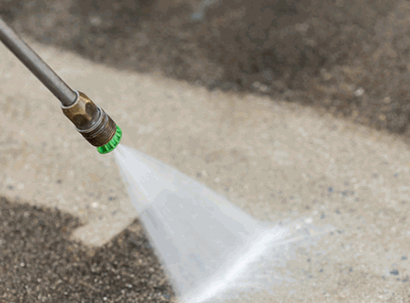
What Are The Tips For Maintaining A Pressure Washer For Patio?
Maintaining a pressure washer involves regular cleaning, proper storage, and timely part replacement to ensure long-term performance and reliability for patio cleaning tasks.
Clean The Pressure Washer After Use
After each use, thoroughly clean the pressure washer to remove any dirt, debris, or detergent residues that could affect its performance.
- Start by rinsing out the detergent tank to ensure no leftover solution remains that could clog the system during the next use.
- Next, wipe down the entire unit with a clean cloth to remove any surface grime or buildup.
- Don’t forget to check for blockages in the nozzles or spray guns, as these can impede the water flow and damage the equipment over time.
Store In A Dry Place
Store your pressure washer in a dry place to prevent damage from moisture and ensure it remains in good working condition for the next use.
Proper storage is crucial for extending the lifespan of your pressure washer. Moisture can lead to rust and corrosion, impacting the effectiveness of the machine. When seeking an ideal storage location, opt for a well-ventilated area away from direct sunlight or extreme temperatures.
Before stowing your pressure washer, take the necessary steps to prepare it for storage. This includes draining any remaining water from the unit to prevent freezing and potential damage. Consider using a fuel stabiliser to prevent fuel-related issues. Taking these precautions will help maintain the performance and longevity of your pressure washer.
Check And Replace Parts Regularly
Regularly check and replace worn or damaged parts of your pressure washer to maintain its efficiency and prolong its lifespan.
Keeping your pressure washer in top condition is essential for optimal performance and longevity. By performing routine checks and part replacements, you can prevent costly breakdowns and ensure your equipment operates smoothly when you need it most.
- Inspect the hoses and fittings: Check for any cracks, leaks, or signs of wear that could affect water flow and pressure. Replace any damaged parts immediately to prevent potential accidents or damage to the machine.
- Examine the nozzle and spray gun: Make sure the nozzle is clear of any debris or blockages that could impede water flow. Replace worn-out nozzles to maintain the desired pressure levels for effective cleaning.
- Don’t forget the pump: Regularly check the pump for any leaks, unusual noises, or pressure issues. If you notice any problems, consider replacing the seals, valves, or pistons to prevent further damage.
